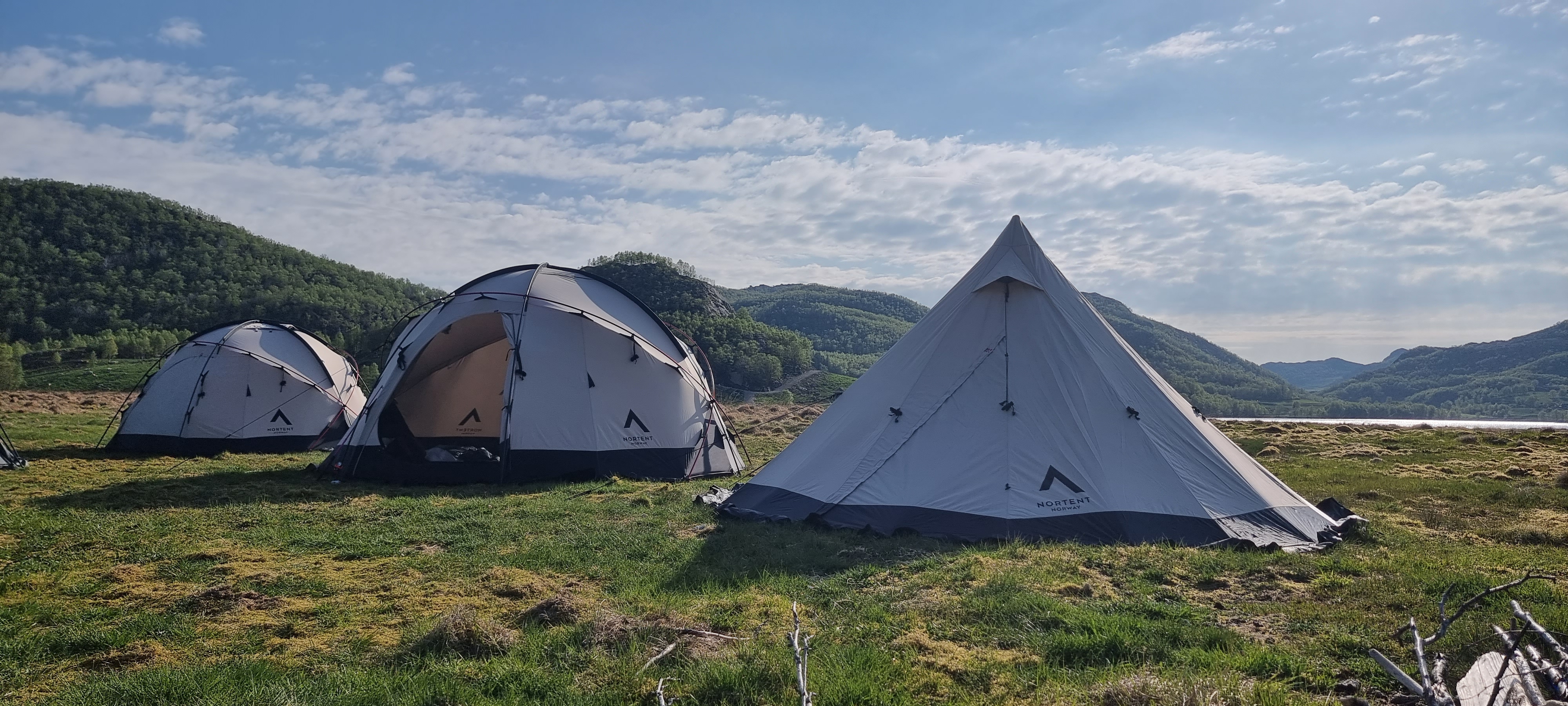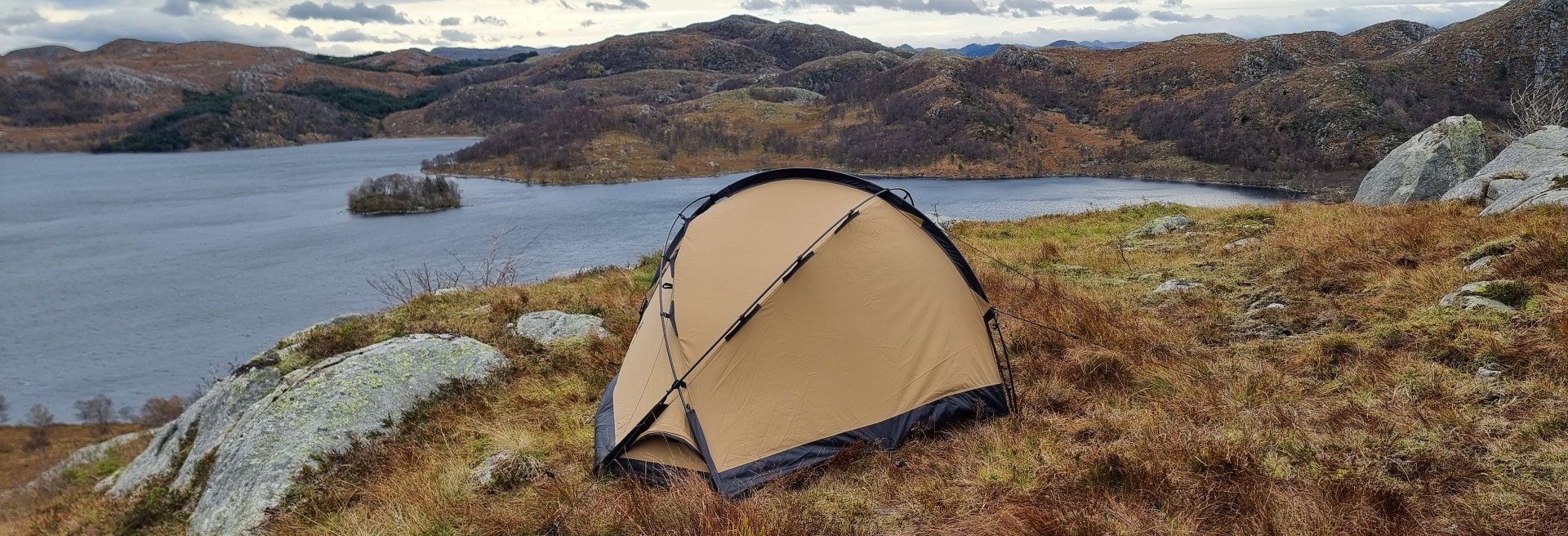Polycotton
With breathable polycotton fabric you avoid condensation on the inside walls of the outer tent. Most tent fabrics need some kind of waterproof coating to make it waterproof. But with polycotton much of the "waterproofing" work is done by the fiber itself. A cotton canvas is not completely waterproof from the factory. It needs to be exposed to water so that the fibers in the fabric expand and thus make the fabric 100% waterproof. Be it from exposure to rain or water from a garden hose, this process is called weathering. This also applies to the thread in the seams. With this in mind it may be good to know that it is normal with a few drops of water coming through the fabric during the first rain showers. The fabric will become denser after each time and eventually become completely waterproof. It is the internal fibers in the tent fabric that are making the fabric completely waterproof. With proper care and storage the tent will maintain its waterproof properties for many years to come with no extra maintenance to waterproofing.
Cotton has a long history as a canvas for tents. Some of the first commercial tents were made of cotton canvas. These tents were warm, with an acceptable indoor climate. We at NORTENT have experience with cotton tents from the army where the cotton tents worked perfectly as shelter and insulation. The big downside, however, was that these tents were too heavy to carry. They had to be brought to camp by motorized transportation.
Eventually we got tents with synthetic fabric, mainly polyester. Polyester was and still is an inexpensive and strong fabric. However, with synthetic fiber it's challenging to keep a good indoor climate. Condensation can easily build up if the air flow is not maintained. In a very humid, environment it is close to impossible to avoid condensation with a fully synthehic flysheet regardless of designs and models. This is where the good properties of polycotton come into play.
Polycotton is, as the name suggests, a fiber- blend of polyester and cotton that preserves the best of both worlds. The cotton makes the canvas breathable where you do not have to constantly fight against the condensation inside the tent. In addition, cotton insulates and gives a much warmer and drier indoor climate. With a proportion of polyester in the cotton fiber, you can make this fabric much lighter and thinner and at the same time maintain the durability of the tent.

Have a look at our Lavvo 6 PC. This would easily have a weight over 20 kilos if the canvas was made out of 100% cotton. With our hybrid fabric made of polycotton we reduce its weight to only 7.5 kilos, and at the same time benefit from all the good properties of a regular cotton canvas. The downside is that they are still heavy compared to tents as light as synthetic tents.
So you have to consider what's important to you. If a dry, warm and ventilating tent are important characteristics for you, then you should spend a few nights in our PC tents. The indoor climate is much better than what a synthetic tent can offer. Because the polycotton fabric is ventilating and breathable, the need for an inner tent is considerably reduced. One of the tasks of an inner tent is to keep the wet and damp tent walls away from the persons living in the tent. The mesh fabric of the inner tent lets through moist air so you avoid condensation inside the inner tent itself. However, if the outer tent is synthetic (non-breathable), condensation will then occur on the inside walls of the outer tent.

With that said. Even though cotton fabrics and tents are breathable, condensation will still occur, especially in damp and cold surroundings with little air movement. This is due to a combination of factors such as air circulation, temperature differences, and humidity:
Air circulation:
Tents are typically equipped with vents to allow air circulation. This helps remove humid air from inside the tent and brings in cooler, fresh air from the outside. However, when the warmer, humid air encounters cooler surfaces, like the tent fabric at night, it can lead to condensation. Air circulation and breathable fabric helps to mitigate, but not always eliminate, this issue. Nevertheless, cotton tents reduce condensation significantly.
Temperature difference:
Nighttime temperatures can be significantly lower than daytime temperatures, especially in mountainous areas or under cold weather conditions. This temperature difference can cause the humidity inside the tent to condense on the inner surface of the tent fabric. This is especially true in particularly humid environments, such as near water or a marsh. Again. Breathable fabric helps to reduce the condensation.
Air circulation:
If the tent is placed in a sheltered or quiet environment, it may have less air circulation, increasing the chances of condensation. Stagnant air makes it harder to remove the accumulated moisture inside the tent. This physical principle applies to all materials, breathable or non-breathable.
There will be situations where condensation occur, especially in environments where the air is stagnant (resulting in poor air circulation), damp, and cold. In such cases, condensation is unavoidable, driven by physical principles that are impossible to avoid. This holds true whether you are in a tent with breathable properties or a non-breathable one. Similarly, in a cold cabin with inadequate air circulation, these physical principles will lead to damp walls inside the cabin unless you ventilate or provide some form of heating.
Breathable polycotton helps to reduce condensation considerably. But it is no magical wand that can bend the laws of nature. End users may however help further to avoid condensation by picking appropriate camping-grounds. Pitching the tent close to the water, stagnate airflow and low temperature. You will experience condensation as condensation is bound to physical principles mentioned above. So. Condensation is always a symbiosis between the design of the tent, the fabric, climate, surroundings and the knowledge from end-user.










